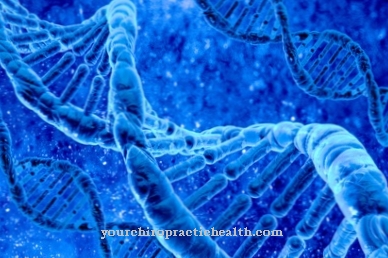Of the Parasympathetic tone is a measure of the state of excitement of the parasympathetic vegetative nervous system as an opponent to the sympathetic nervous system. A high parasympathetic tone has a calming effect on the internal organs, enables regeneration and serves to build up reserves. The body is brought back into normal mode from the sympathetically controlled exceptional situation in which the body is prepared for maximum performance and for escape or attack.
What is Parasympathetic Tone?

The vegetative or autonomic nervous system, through which most body and organ functions are controlled independently of the will, consists of the sympathetic, parasympathetic and enteric nervous system (the nervous system for the digestive tract, which is also autonomous, but also on signals from the sympathetic and of the parasympathetic nervous system).
The parasympathetic and sympathetic nerves can be understood as antagonists, but also work together synergistically in sudden stressful situations by putting the body into alarm mode as best as possible.
While a high sympathetic tone is associated with an increased concentration of stress hormones and adjusts the body to maximum physical performance and flight or fight, the parasympathetic tone brings the body back out of the exceptional situation by blocking the stress hormones. He initiates a metabolic program that serves to regenerate, build up and reduce stress.
There is a sophisticated interplay between sympathetic and parasympathetic tone for the diverse control of the internal organs, the metabolism and the hormonal balance. A direct measurement of the parasympathetic tone is not possible because the parasympathetic system mainly has an inhibitory effect on the concentration of stress hormones. The concentration of acetylcholine, a neurotransmitter that has an inhibitory effect on the stress hormone cortisol, provides a certain indication of the parasympathetic tone. In this way, conclusions can be drawn about the respective parasympathetic tone by measuring the cortisol concentration and the heart rate variability.
Function & task
The parasympathetic tone provides an indication of the current activity of the parasympathetic autonomic nervous system, which must always be seen in connection with the function and tasks of the sympathetic nervous system. On the one hand, the parasympathetic tone acts as an antagonist of the sympathetic tone, on the other hand, the parasympathetic nervous system can also work synergistically, i.e. in addition, with the sympathetic system.
This happens above all in sudden stressful situations in which the metabolism programs the body with a multitude of individual reactions for maximum performance while at the same time reducing the risk of bleeding in the event of injuries. The metabolism is briefly prepared for flight or attack. The change in body functions due to a high level of stress can e.g. T. be harmful, such as the rise in blood pressure. Therefore, increasing the parasympathetic tone after the end of an acute stressful situation serves the purpose of returning the circulation and metabolism to normal mode as soon as possible. This gives the body and muscle tissue the opportunity to regenerate and build up reserves.
Aside from the global change in metabolism, the parasympathetic tone affects the function of some internal organs such as the heart, bronchi, digestive tract, gall bladder, liver, pancreas, ureters and others.
In the heart, an increase in parasympathetic tone causes the heart rate to slow down, a slowdown in the conduction of excitation from the sinus node in the right atrium to the AV node and within the AV node, so that the signal for the contraction of the two chambers is slightly delayed.
In the bronchi, an increased parasympathetic tone leads to an expansion of the blood vessels (vasodilation), so that a stronger blood flow takes place and therefore a stronger secretion of mucus as well as a narrowing of the bronchi takes place. In the digestive tract, the parasympathetic nervous system influences its own autonomic nervous system, the enteric nervous system, and makes it more active.
In addition to sexual arousal, men need a certain parasympathetic tone for an erection to occur. The smooth circular muscles that clasp the cavernous arteries relax under the parasympathetic influence, allowing blood to shoot into the cavernous bodies and cause an erection.
You can find your medication here
➔ Medicines to calm down and strengthen nervesIllnesses & ailments
A change in the parasympathetic tone in interplay with the sympathetic tone is subject to many influences and can be severely disrupted by diseases, drugs or toxins. The most common complaints that result from a disturbance of the balance between the two antagonists are attributed to the changed way of life compared to ancient societies. Especially people who frequently experience stressful conditions that cannot be relieved by increased physical activity suffer from permanently increased levels of stress hormones.
The parasympathetic tone can be too low under such conditions, so that the metabolism is dominated by the sympathetic tone and corresponding symptoms such as primary high blood pressure, sleep disorders, restlessness or similar symptoms can arise. The digestive tract can also exhibit functional disorders due to a too low parasympathetic tone due to missing or too weak impulses from the parasympathetic system.
A few decades ago, the diagnosis of vegetative dystonia was often made in the case of unspecific complaints that were due to an obvious malfunction of the autonomic nervous system. This term is controversial today because it is often “just” a disturbed balance between sympathetic and parasympathetic tone.
Primary nerve disorders that lead to similar symptoms are very rare. However, sensitive disorders can be triggered by neurotoxins, which are also synthesized in nature in the form of poisonous spiders, snakes, box jellyfish and other animals and used to catch prey or to ward off attacks.
If parasympathetic tone disorders are diagnosed, drugs are available that stimulate the parasympathetic system or inhibit activity.




























.jpg)